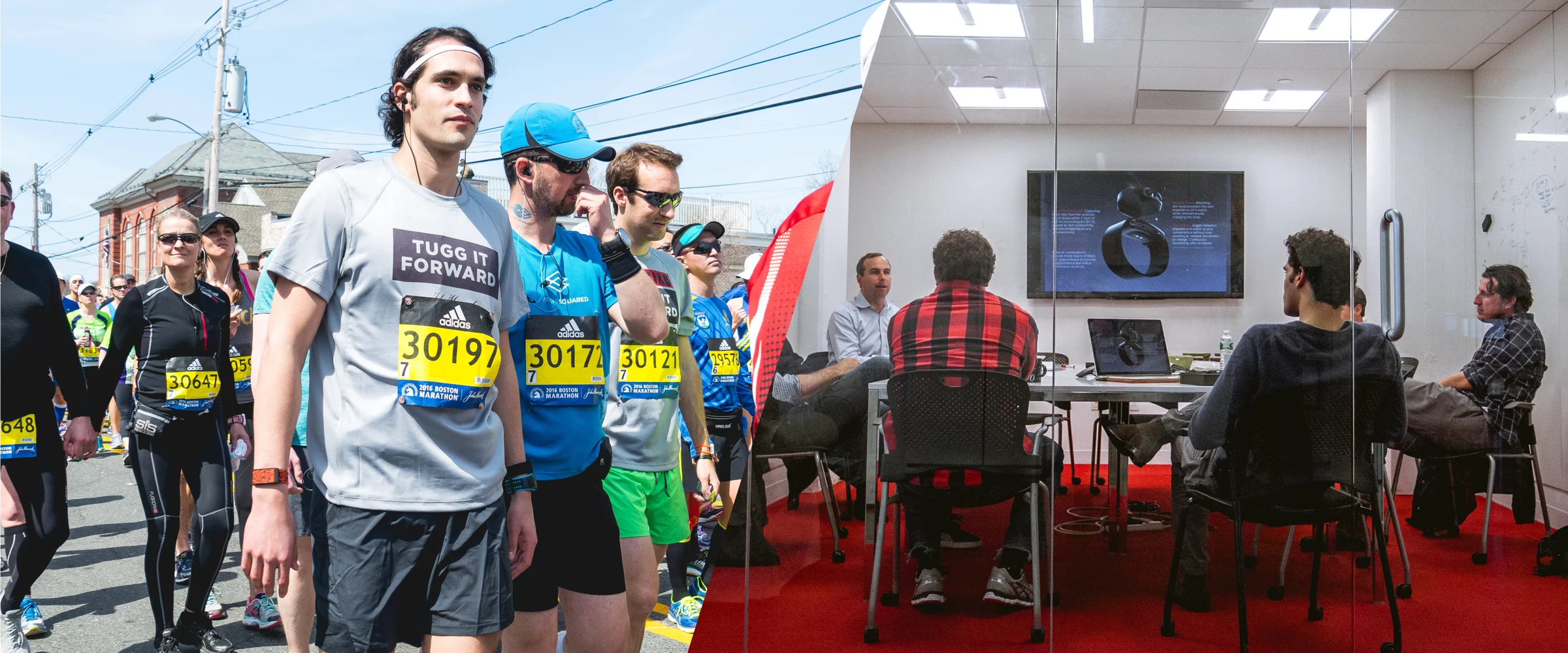Topics
- Article
My Product Launch was Harder than a Marathon to Recover From

A Story of Stress vs. Strain: How My Product Launch was Harder to Recover from than the Boston Marathon
Yes, your day job may be harder to recover from than a marathon. It was for me.
___
On April 18, 2016, I ran the Boston Marathon. It was my first marathon and, despite being a former Division I athlete and someone who exercises regularly, I wasn’t physically prepared. I was injured for six weeks leading up to the race and my longest successful run before it was only 14 miles. My last long run prior to the marathon was in 12-degree weather and, on race day, it was 70 degrees in Boston.
After 10 miles I had such intense cramps in both my legs that I found myself lying on my back on the side of the road getting massaged by fans–not a great feeling with more than 16 miles to go. Over the remainder of the race I entered eight medical tents for treatment, where I received leg massages, salt tablets and water gels.
I probably should have quit.
But I was running for TUGG and Level Ground MMA, as well as the people who trained alongside me. My mind is stronger than my body. At least that’s what I always tell myself.
On July 18, 2016, three months to the day after I ran the marathon, we announced the launch of the WHOOP Strap 2.0, our first product available to the public. I was up late into the night all weekend preparing videos and designs for our website. Then on Monday morning, we issued a press release about Strap 2.0 and all of our Olympians training for Rio. I travelled down to Manhattan for eight different interviews: USA Today, NBC, Wall Street Journal, NPR, Reuters, Yahoo, Wired… A combination of television, radio, and print. It was a busy day to say the least. Throughout the rest of the week I followed up on the interviews and watched our sales spike. I had survived and I actually felt pretty good.
But, therein lies the problem with how we understand our own bodies.
At WHOOP, we do a lot to monitor the human body, especially for athletes. WHOOP is the first wearable company to frame the world in terms of Strain and Recovery. Strain is the amount of cardiovascular load undergone in a workout or over the course of the day; Recovery is how prepared your body is to take on Strain.
There are two important ways to monitor the Strain-Recovery relationship. First, on a daily basis, you want to match your body’s Strain with its level of Recovery. If you have a higher Recovery, you want to take on more Strain and if you have a lower Recovery, you should take on less (or just rest). It’s a pretty simple concept that billions of people every day have no notion of. For athletes, that relationship determines whether they’re overtraining (a leading cause of injury), undertraining, or training optimally. We have a number of case studies to prove the importance of this relationship.
The second way to monitor this relationship is by examining how fast your body can recover from Strain. For example, if you run a marathon, how long did it take for your body to fully recover? Well, I’ll tell you.
I’ve been wearing a WHOOP Strap 24/7 for nearly four years, which to my knowledge is one of the largest collections of continuous, accurate physiological data ever recorded on a human being. That’s exciting because it means I have an overwhelming amount of data to baseline myself throughout different periods of time.
Using WHOOP data, here’s how my body responded to both the marathon and the product launch compared to my one-year average:
Average:
HRV
Sleep Need
Hours of Sleep
Recovery
4/19/16 – 4/25/16
Post Marathon
85
80%
7.1
57.3
7/18/16 – 7/24/16
Post Product Launch
77
69%
6.4
44.7
8/23/15 – 8/23/16
Full Year
95
79%
6.9
64.5
I highlight in red the metrics that are the worst in a particular category, and in green the metrics that are the best. HRV stands for Heart Rate Variability. If you don’t know what HRV is, you can read about it here. In short, it’s the key into understanding your autonomic nervous system. Previously, it could only be monitored via ECGs in hospitals. Then more recently, by chest straps. Now, WHOOP monitors HRV from the comfort of a wrist-worn device. Mark my words, one day every living human will continuously tracking their HRV; it’s that powerful.
HRV and WHOOP Recovery are the two most important metrics for understanding how well my body was bouncing back from the Strain of the marathon and the product launch. Not surprisingly, my HRV and Recovery were dramatically lower than my one-year averages during these two stressful weeks.
The most fascinating finding here? My product launch was significantly harder to recover from than my 26.2-mile race. During the product launch, my HRV was 20% lower than my one-year average and clearly I wasn’t sleeping well. It’s interesting that I slept slightly better following the marathon than even my one-year average. This isn’t unusual: We’ve seen physical strain improve sleep performance for athletes, while stress can have the opposite effect.
If you’re an athlete, or specifically a runner, you can understand how completing my first marathon left me physically exhausted for weeks. And if you’re a founder, CEO or executive, you can sympathize with the fact that releasing my startup’s first product to the public was incredibly draining. But, would you have thought the product launch would take more out of me?
Yes, your day job may be harder to recover from than a marathon. It was for me.
Make sure to check out @whoop on Instagram, Twitter and Facebook.